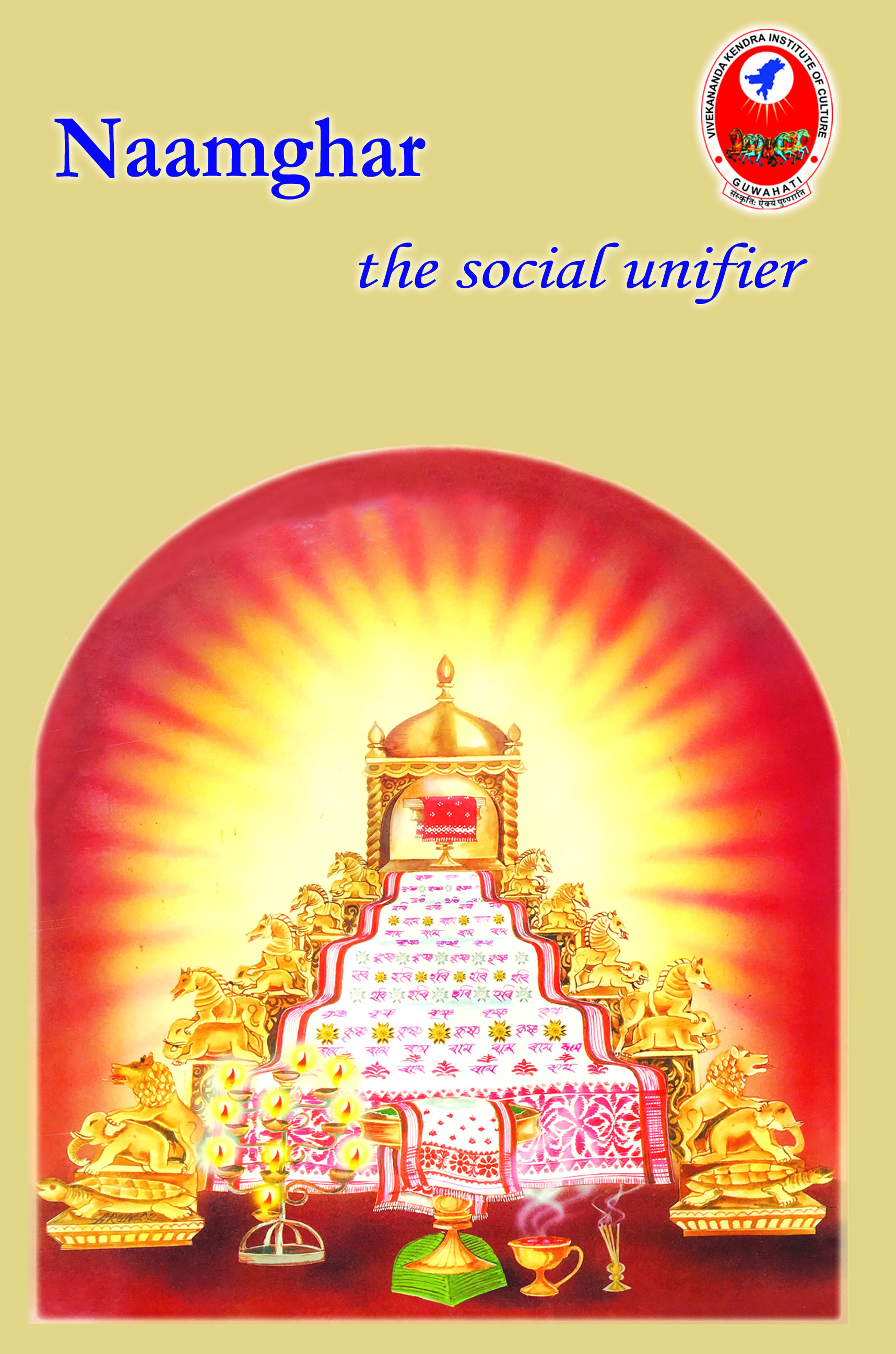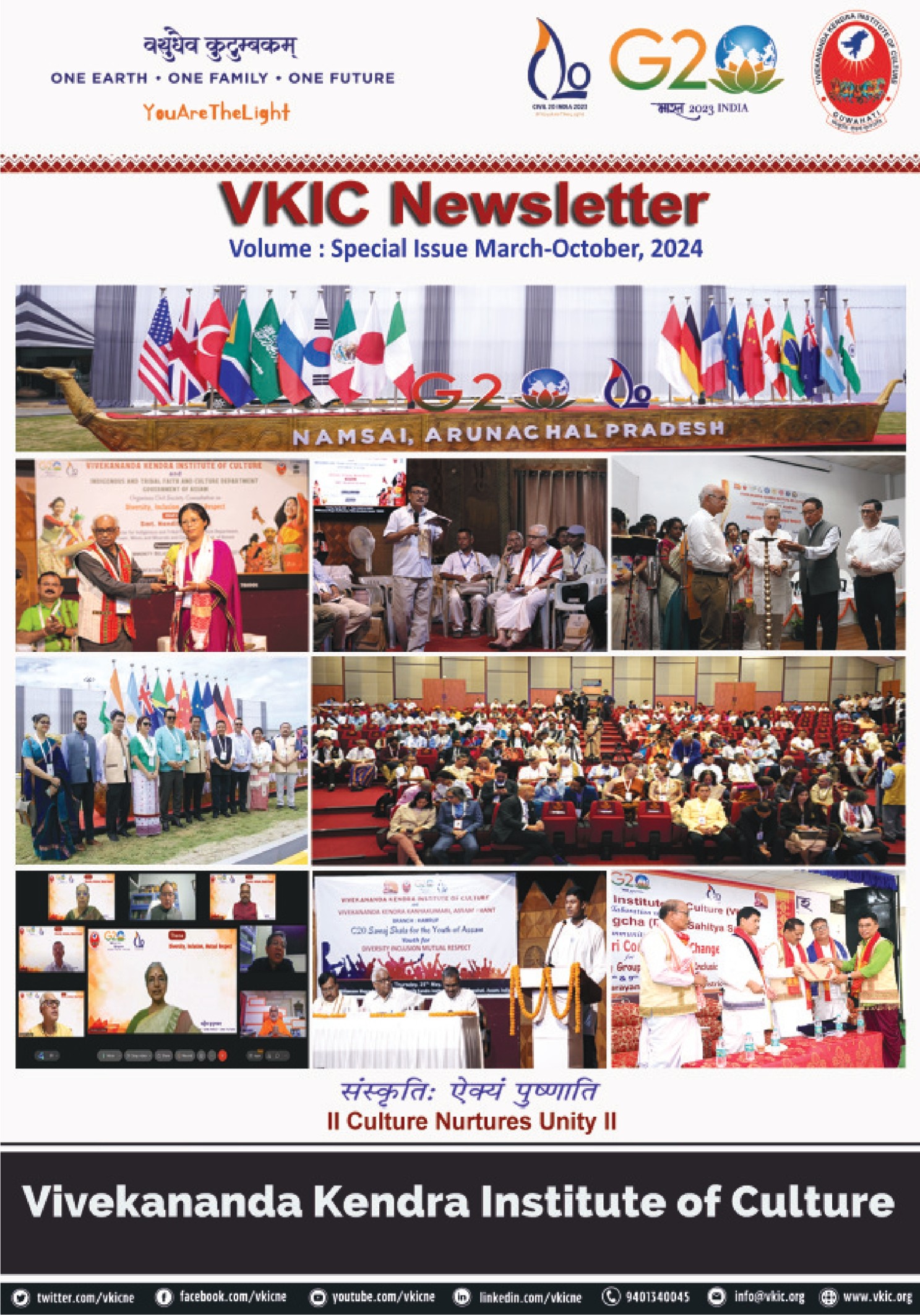A Vivekananda Kendra Institute of Culture publication of 2019 of the Sanskriti Anveshak (SA) series of interactive session on Namghar which was held during 2013-14. There were 12 such sessions on Namghar and of these 8 sessions has been published in this publication.
 ‘The Namghar as a Vibrant Platform of State-Civil Society Interface: A Perspective’ was one such session where Dr Abhijit Bhuyan deliberated on the subject. The author in his article discussed the Namghar as an effective age-old civil society institution which still continues to facilitate social cohesion and build bridges across communities in Assam. He strongly feels that the Namghar is intrinsically equipped to act as a platform and apolitical space to spread the message of peace, social harmony and integration central to the Vaishnavite philosophy. And such a unified and cohesive institution would aim at confronting and engaging the hegemonies of power and structural dysfunctionalities whether at the level of public governance or in terms of the operational dynamics of market forces. This article will be a very interesting read in this time of India’s Presidency in G20 where one of the Engagement Groups is the Civil 20 or C20 in short.
‘The Namghar as a Vibrant Platform of State-Civil Society Interface: A Perspective’ was one such session where Dr Abhijit Bhuyan deliberated on the subject. The author in his article discussed the Namghar as an effective age-old civil society institution which still continues to facilitate social cohesion and build bridges across communities in Assam. He strongly feels that the Namghar is intrinsically equipped to act as a platform and apolitical space to spread the message of peace, social harmony and integration central to the Vaishnavite philosophy. And such a unified and cohesive institution would aim at confronting and engaging the hegemonies of power and structural dysfunctionalities whether at the level of public governance or in terms of the operational dynamics of market forces. This article will be a very interesting read in this time of India’s Presidency in G20 where one of the Engagement Groups is the Civil 20 or C20 in short.
Another session on SA was on ‘A Community Centre for Human Capacity Development’ by Dr Eeshankur Saikia. The author goes on to question whether the Namghar which is a community center playing the role of a nuclei for human capacity development still continues to do so and if not what changes or innovations needs to be brought about to continue playing that role. He analyses through his article the five different layers which are interconnected, interrelated and interdependent and which helps a human being to grow or develop as a personality. He starts with the outer layer i.e., the Economy, then moving on to Education, Health & Hygiene, Culture and to Spirituality which is the core of the human development and also the changes and innovations which he feels needs to be initiated in order to ensure the vibrancy and authority which a Namghar used to have in yesteryear's.
One of the sessions was on ‘Namghar – a Socio-Cultural Educational Institution’, by Sri Pulin Kalita and the article in Assamese. Like any other place of worship, Namghar too is one such place but looks beyond being only a place for worship. The author starts on with a general description of the Namghar and shares how the institution, an important place of worship of the Assamese community is a unique contribution to the Hindu Dharma in its evolving journey. The Namghar, an evolution in the Vaishnavite tradition in the Hindu Dharma is a center for collective consciousness and is focused on one Hindu God – Krishna. He goes on to explain how the Namghar is actually a ‘Center of Education for Society and Culture’ and explains the different curricula like that of architecture, sculpture, musical instruments, dance & music, bhaona, and naam-prasang.
Moronga Namghar, a write-up by Sri P.K.Das on the basis of an interaction with Sri Atul Raja, the Atoi of the Namghar. The Namghar located about 8 km from the Guwahati – Shillong Road near Nongpoh in Meghalaya still stands today as an example of Srimanta Sankaradeva’s works amongst the Janajati communities. This Namghar was established in 1961, in the then undivided Assam when Meghalaya was still a part of Assam with the initiative and help of Srimanta Sankar Mandir, Bishnupur in Shillong. The then Chief Minister of Assam Bishnuram Medhi took a keen interest in the establishment of the Namghar.The people associated with this Namghar are from the Tiwa, Armi Karbi, Rani Luki and Rani Beltola communities and from the nearby settlements covering eight villages. Around forty families are associated with this Namghar and a description about the various activities of the Namghar and its present state of affairs is mentioned.
There is an article on ‘Namghar as an Institution of Self-Governance ‘written by Dr Rahul S Mazumdar. A well-researched article, Dr Mazumdar presents the Namghar as the center of self-government – ‘Panchayat Raj’ and a co-operative educational center. In a village, whenever any problem or situation arises, the villagers gather at the premises or courtyard of the Namghar to discuss amongst themselves for a solution. Although elderly and influential members of the society take a leading part in the discussion and decision making, yet the authority to decide or in arriving at a solution always rest in the collective gathering which is termed as ‘raaij’. The persons found guilty are asked to undergo appropriate compensation or fined, failing which they might also be excommunicated from the society.This article discusses many aspects about matters relating to the society and collective actions where the Namghar plays its natural role of governance.
One of the sessions was a demonstration cum lecture on Rampur Namghar presented by the Bhakats of the Namghar. Sri Kapil Choudhury, a bhakat of the Namghar and a High School teacher by profession gave a write-up in Assamese which was published as one of the pieces. A very old Namghar established in 1920 with the efforts of the villages distributed around 14 subas and was called ‘Sanatan Dharma Mandir’. This Namghar has a manikut and in the year 1942 the ‘Radha-Krishna’ idol was also established. Majority of the devotees of the Namghar is from the Damodar panthi. The Mandir is looked after by a Medi on a day-to-day basis and there is a Management Committee to look after its affairs. The author has written in details about the various festivals and programmes which is observed by the Mandir and will be an interesting read.
The last session in this SA series was on ‘Namghar and Assam’ and was deliberated upon by Sri Bhaskarjyoti Mahanta, IPS. Through his article, Shri Mahanta has emphasized that Namghar and the Assamese Society is one and the same thing, for the basic values and ethos of the Assamese society lies in the Namghar. But then, he also cautioned us that there has been some erosion of the values and ethos from this institution and needs to be re-discovered once again in order to strengthen the society. The author, while sharing about the unique position of this institute in the pursuit of a creative and a purposeful life with all the education it opens up for the all-round development of a personality opined that it is time to structure and formalize some of the aspects which can manage this important institution purposefully for which it has been ordained. The author has pointed out five different areas concerning the Namghar which needs to be pondered upon and appealed to all to work towards strengthening the Namghar as an Institution.
The last piece in this publication is titled ‘The Namghar in Focus – Lessons learned and the road ahead…..’ and is an outcome of a brainstorming session organized amongst select participants who attended the SA series consistently to find about the lessons learnt and what could be a way ahead after this series and publication. This piece details 16 different core areas concerning the Namghar which needs to be protected, preserved and promoted in order to keep the perennial teachings of Srimanta Sankaradeva alive and implementable. It also identifies 6 areas of changes in the Namghars and are being put forward to be pondered upon as to whether it is for the good of the society at large. And lastly, it also shares about the ‘Road Ahead’ a]. On a public level – on a larger whole and B]. On a selective level – to initiate an effective model Namghar.


